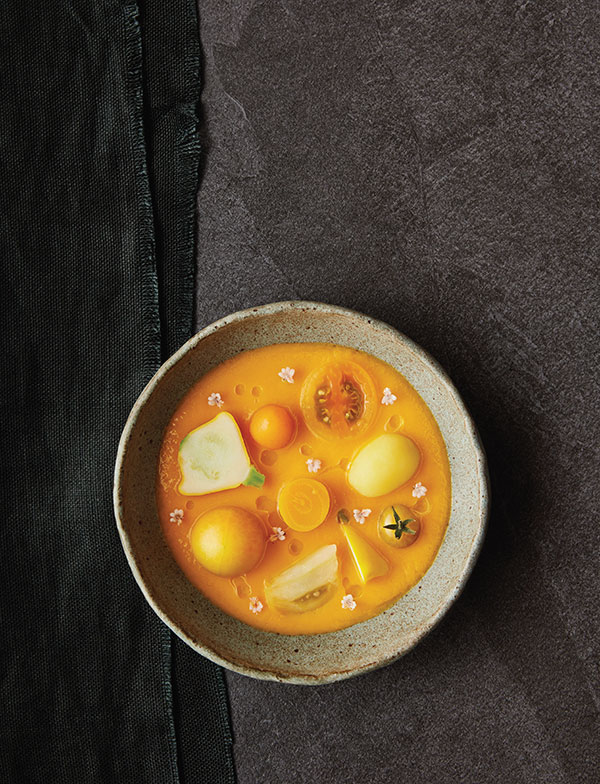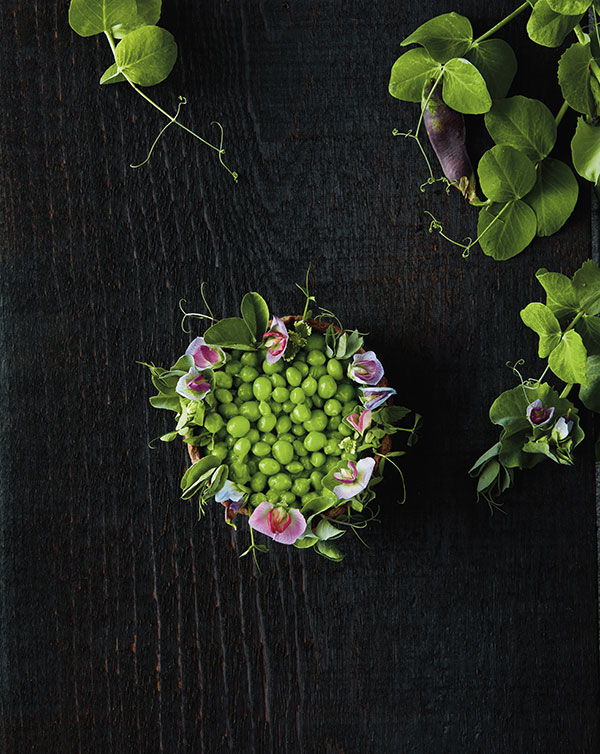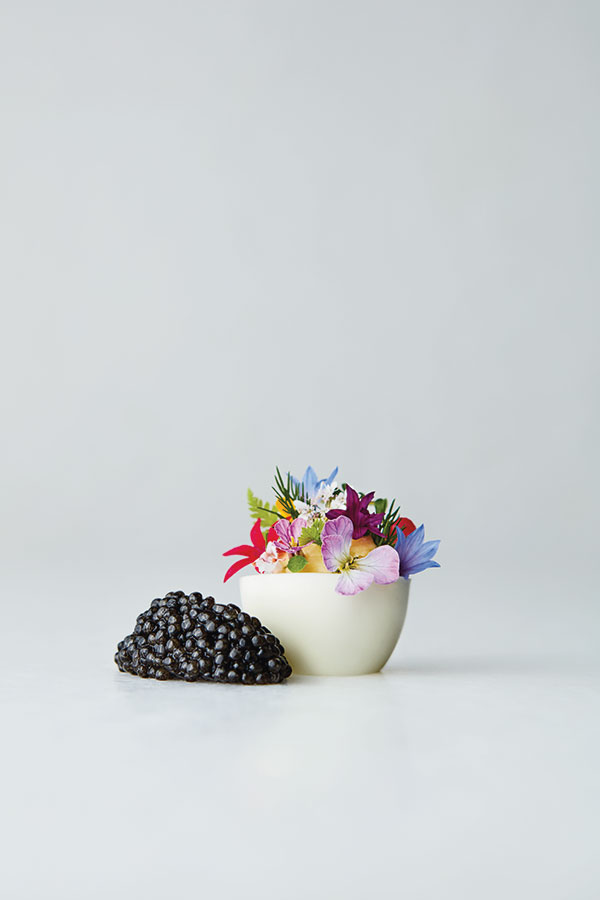A Taste of Ontario’s Langdon Hall With Recipes (and Culinary Tips) From Chef Jason Bangerter

These recipes from Langdon Hall Country House Hotel & Spa in southwest Ontario focus on seasonal, locally grown ingredients. Photo: Colin Faulkner
Jason Bangerter loves chickens. He really loves chickens.
This is evident by a photo in his new book, Langdon Hall: A Cookbook, co-created with writer Chris Johns. He clutches a chicken, quite lovingly, though the chicken is clearly ignorant of the moment soon to come. The penultimate moment makes a better photo, anyway.
Through pages of lavish photography — featuring images of Langdon Hall’s verdant gardens, lush Carolinian forests and gorgeously plated dishes showcasing foraged ingredients and wildflowers — it becomes abundantly clear that Bangerter is in his element. His natural habitat, if you will.
The chef arrived at Langdon Hall, the gastronomic inn in the town of Cambridge, Ont., about an hour northwest of Toronto, on a neighbourly visit eight years ago. He was working as executive chef at Auberge de Pommier in Toronto, one of the city’s top classic-style French restaurants. So he wasn’t looking for a job, but he took it when it was offered, recognizing a fantastic opportunity when he saw it. Since then, the Langdon Hall kitchen team has earned multiple recognitions, including several placements on the list of Canada’s 100 Best Restaurants. It’s something of a homecoming, given that he grew up nearby in Milton. He and his wife now live in the area, with two sons and a husky named Wild.


This is his first cookbook. Though, it’s somewhat more than a cookbook.
“My goal was always for it to be a coffee-table book — before cooking literature,” he says. “To showcase the beauty of everything that I do, and that juxtaposition of rawness of the terroir transformed onto the plate. And also the beauty of the property and the history — how majestic and legendary this place is. I think we captured that. You look through this and you’re in awe not only of the beauty of the place, but also of the cuisine and the stories. And if you wanted to cook something, you can do that as well.”
He has some advice for home cooks attempting the recipes: Don’t be afraid, you got this.
“These are actual dishes we served in the hotel over about 18 months,” he says. “There are dishes that’ll take 20 minutes to prepare, and some that’ll take three days. The recipes may look intimidating, but the way I describe the processes, I’ve made it simple to understand. I’m not using restaurant terms. I’m describing exactly each step, walking you through it. I’m not talking to a trained professional. Some dishes might have six components — but you don’t have to do the whole dish. Just take a sauce, say, and have it with the poached fish.”
Plan appropriately and have everything ready — but don’t forget to have a good time.
“Enjoy the book, read the stories, and when you’re ready to cook, plan it out. Have a great weekend: start on Friday night and finish it Saturday evening. Have some fun, enjoy some wine, invite some friends.”
Insider Tips From Chef Jason Bangerter
For a flavour booster, I use a lot of lime leaf. We have it in our greenhouse.
Dress up a plate with flowers and fresh herbs. Some easy-to-grow things — whether in a pot or small plot of land — like nasturtium, marigold, thyme, dill, basil, cilantro, chives. Pretty easy to manage at the home level.
Use nutritional yeast to add umami — it’s like adding parmesan, without the dairy. I’ll even use it to finish a dish, like a vegan risotto, instead of cheese.
Taste your dish at every stage of cooking, don’t wait until the end. Every step of the recipe should taste delicious. You should be a part of it through the whole process, adjusting seasonings as you go.
For Easy Entertaining
A one-pot meal … get a nice fresh cod or spot prawns and a big pan. Rough chop shallot, ginger, spring onion, garlic. Gently sweat, throw in some peas, and slice the fish and add it along with some white wine and a big handful of chopped herbs. Cover it for one minute and it’s ready. With a big piece of crusty bread and a nice glass of wine. It’s fresh, and delicious and healthy.
Pantry/Fridge Must-Haves
Parmesan, dried pasta, mustard, honey or maple syrup, chili or chili pastes. And nutritional yeast. Always garlic. Those are the flavour triggers.
Finding Comfort
I love pasta! When I worked in St. Moritz, the restaurant team would yell at me if I didn’t make pasta at every staff meal. Parmesan cheese, olive oil, butter and pasta — really simple and delicious. Or a meat ragu. Or a margherita pizza with a glass of Chianti.
Snack Attack
I love raw vegetables. Part of being with a property, you pull a carrot of the ground and it’s like nothing you’ve tasted before. Everything tastes so delicious and perfect. A big bowl of nice chilled fresh vegetables, honey butter, flavoured crème fraîche, hummus, etc. Or I’ll fry up some chips. M&Ms with popcorn is a real treat! My kids will go to Baskin-Robbins and get Chocolate Chip and Gold Medal Ribbon.
Multigenerational
My kids are great cooks. Christian baked five test cakes to see which one he preferred for his birthday. Sebastian likes to barbecue, and I’ve got him into Bolognese … he likes to cook it once a week!
RECIPES
Golden Vegetable Soup With Olive Oil and Basil Blossoms

At the height of summer, when so many golden vegetables — golden beets, golden tomatoes, yellow pattypan squash and golden potatoes — are at their peak and super ripe and tasty, this simple chilled soup is a great way to get a real taste of the season. Garnish this with a few basil flowers or leaves, some good-quality cold-pressed canola or extra-virgin olive oil and a little bit of sea salt and you’re ready to go. This soup is equally delicious served hot.
Serves 6
Ingredients:
½ cup olive oil
1 cup roughly sliced shallots
1 tablespoon roughly sliced garlic
½ teaspoon minced peeled fresh ginger
1 cup roughly chopped orange bell pepper
1 teaspoon kosher salt
1 teaspoon freshly ground white pepper
½ cup lightly packed fresh basil leaves
½ cup lightly packed fresh flat-leaf parsley
½ cup dry white wine
4 cups roughly chopped orange tomatoes
2 cups roughly chopped peeled English cucumber
Green jalapeno Tabasco sauce
Garnishes:
6 boiled and peeled new potatoes, cut into bite-size pieces
3 boiled and peeled golden beets, cut into bite-size pieces
6 blanched pattypan squash, cut into bite-size pieces
6 ground cherries, pitted
12 blanched and peeled golden cherry tomatoes
Basil flowers or leaves
Extra-virgin olive oil, to drizzle
Sea salt
Instructions:
Golden Vegetable Soup:
1. In a medium saucepan, heat the olive oil over medium-low heat. Add the shallots, garlic, ginger and bell pepper and gently cook without browning, stirring often, until tender, about 5 minutes. Season with the salt and pepper. Tie the basil and parsley into a sachet using cheesecloth and butcher’s twine. Add the white wine and herb sachet to the saucepan and reduce the wine by two-thirds. Stir in the tomatoes and cucumber and cook for another 5 minutes. Remove from the heat and allow to cool.
2. Remove the herb sachet and squeeze as much liquid as possible back into the saucepan. Discard the herb sachet. Strain the liquid into another container, reserving it for adjusting the consistency of the soup. In a high-speed blender, puree the vegetables, adding enough liquid in a slow, steady stream while blending to achieve a smooth, velvety consistency. When processed, adjust the seasoning with a splash of jalapeno Tabasco sauce and more salt, if required.
3. Strain through a fine-mesh sieve into a medium bowl and chill over ice. The soup can be stored, covered, in the refrigerator for up to 4 days.
To Serve:
Pour the soup into chilled soup bowls. Gently place the prepared potatoes, beets, squash, ground cherries and golden cherry tomatoes into the soup. Finish with basil flowers or leaves, a drizzle of olive oil and a sprinkle of sea salt.
Sweet Pea Tart With Peas From the Garden and Buckwheat

Small tarts are ideal for a canapé, as a light appetizer or as a nice lunch along with a soup or salad. They also make a great vehicle for celebrating the seasons. For this pea tart, we start by filling the shell with a spoonful of crème fraîche that we top with a thick pea puree and finish with lightly minted fresh peas that are briefly but perfectly cooked and then refreshed in ice water so they stay bright and green and pop with juicy green springtime flavour. It’s a taste of the new season in one mouthful.
Serves 4
Ingredients:
Buckwheat Tart Shell:
1 cup buckwheat flour
1 cup all-purpose flour
2 teaspoons sugar
¼ teaspoon kosher salt
1 cup chilled unsalted butter, cubed
2 large egg whites
2 teaspoons water, if needed
Mint Oil:
1 cup lightly packed fresh mint leaves
½ cup vegetable oil
Fresh Spring Peas:
1 cup shucked fresh peas
½ tablespoon mint oil (recipe above)
¼ teaspoon kosher salt
Garnishes:
2 tablespoons crème fraiche
2 tablespoons English Pea Puree
Fresh mint leaves
Pea flowers
Pea tendrils
Flaky sea salt
Instructions:
Buckwheat Tart Shell:
1. In the bowl of a stand mixer fitted with the paddle attachment, mix together the buckwheat flour, all-purpose flour, sugar and salt. On low speed, add the chilled butter, a few pieces at a time, until the mixture resembles crumbly coarse sand with a few pea-sized pieces of butter still visible. Add the egg whites and continue to mix on low speed just until the dough forms a ball that holds together. Add the water if necessary and bring the dough together.
2. Transfer the dough onto a work surface and flatten and shape it into a ½-inch-thick disc. Wrap in plastic and chill for at least 2 hours in the refrigerator.
3. On a lightly floured surface, roll the dough out to 1/16-inch thickness. Cut out 4 circles with a 5-inch rough cutter and fit each circle into a 3-inch tart pan with removable bottom, gently pressing it into the corners and up the sides. Trim the dough flush with the top of the pans. Chill the shells for 30 minutes before baking.
4. Preheat the oven to 350°F (180°C).
5. Arrange the tart pans on a small baking sheet. Prick the base of the pastry with a fork. Line each pan with parchment paper and fill with baking beans or rice. Blind bake the shells for 10 minutes, until the dough is baked and set. Remove the parchment and beans and continue to bake for another 5 minutes or until the dough is cooked through on the bottom and golden brown. Transfer to a rack and allow to cool completely. Remove the shells from the tart pans before serving.
Mint Oil:
1. Fill a medium bowl with ice water. Bring a medium saucepan of salted water to a boil. Blanch the mint in the pot of boiling water for 10 seconds. Drain the mint and plunge it into the ice water. When cool, drain the mint and squeeze out any excess water. In a blender, blend the mint and vegetable oil for 2 minutes.
2. Strain through a fine-mesh sieve, several layers of cheesecloth or a coffee filter into a mason jar. Allow to cool, seal the jar with the lid and keep in the refrigerator until ready to use.
Spring Fresh Peas:
1. Fill a medium bowl with ice water. Bring a medium saucepan of salted water to a boil. Add the peas and blanch for 1 minute. Drain the peas and add them to the ice water to cool rapidly. This will stop the cooking and preserve their bright green colour. When cool, drain and dry on paper towel.
2. In a small bowl, combine the blanched peas, the mint oil and the salt. Gently mix until the peas are coated with the oil.
To Serve:
Spoon ½ tablespoon of crème fraiche into each tart shell and smooth it into a level puddle. Repeat with the pea puree. Carefully spoon the seasoned peas into the tart shell, filling it to the edge. Garnish the rim with mint, pea flowers and pea tendrils. Spring with some flaky sea salt.
JB’S Tip:
This recipe is very versatile and works with just about any ripe, seasonal vegetable: try peeled cherry tomatoes, grilled zucchini or confit eggplant. If you want to take it in a sweet direction, you could simply replace the peas with fresh berries.
Well-Dressed Peewee Hen Eggs With Caviar, Greenhouse Flowers and Herbs

Caviar service is often accompanied by snipped chives, mounds of minced shallots and boiled egg yolks and egg whites. For this dish, I wanted to have some fun and bring the whole egg and garden favourites to the pantry instead. Working so closely with the gardening team and farmers in our area has introduced me to many new ingredients and interesting characters that inspire new ideas and playful creations. It was through our relationship with farmer Murray, for example, that I learned young adolescent chicks lay eggs, too. Peewee eggs, they’re called. You don’t usually see then at the market or in the grocery store, but everyone once in a while we get them at Langdon Hall. They are the perfect size for a canapé or fun modern twist on caviar service. Here we use heritage hen peewee eggs from Murray’s farm in a playful nod to the devilled egg, alongside Canadian caviar and the ever-changing beautiful garden garnishes harvested from the Langdon Hall greenhouse.
Ingredients:
Aioli (makes extra):
2 large egg yolks
1 garlic clove, finely minced or grated with a Microplane
½ tablespoon fresh lemon juice
1 teaspoon white wine vinegar
1 teaspoon Dijon mustard
1 cup vegetable oil
½ tablespoon olive oil
1 teaspoon kosher salt
Devilled Eggs:
6 peewee or regular eggs, simmered for 10 minutes, cooled and peeled
2 tablespoons aioli (recipe above)
1 teaspoon Dijon mustard
1 teaspoon kosher salt
Garnishes (any or all):
Shiso leaves
Basil leaves
Chervil leaves and flowers
Bachelor’s button petals
Nasturtium leaves and flowers
Dill leaves and flowers
Fennel fronds
Marigold leaves and flowers
Canadian sturgeon caviar, for serving
Instructions:
Aioli:
1. In a medium bowl, whisk the egg yolks with the garlic, lemon juice, white wine vinegar and mustard to mix well. While whisking, add the vegetable oil in a thin stream, followed by the olive oil, whisking continuously to emulsify. The aioli will thicken to the texture of a silky mayonnaise. If it becomes too thick, thin it with a few drops of room-temperature water. Stir in the salt. Transfer the aioli to a covered container and refrigerate for up to 5 days.
Devilled Eggs:
1. With a sharp knife, cut a thin slice from the top and bottom of each egg so they will sit upright once halved. Evenly slice the eggs in half crosswise. Remove the yolks and reserve for the filling. The egg white should have a cup shape. Rinse the egg whites in the water to clean out any remaining yolk and dry them on paper towel.
2. In a food processor, puree the reserved egg yolks with the aioli and mustard until you have a smooth, creamy texture without lumps. If there are lumps, pass the mixture through a fine-mesh sieve. Season with salt.
To Serve: Using a teaspoon or a piping bag fitted with a plain tip, fill each egg white cup with the yolk mixture. Garnish the top with soft herbs and edible flowers. To finish, place a generous spoonful of Canadian sturgeon caviar on the side.
Excerpted from Langdon Hall by Jason Bangerter and Chris Johns. Copyright © 2022 by Langdon Hall Country House Hotel and Spa. Photography © 2022 Colin Faulkner. Published by Penguin Canada, a division of Penguin Random House Canada Limited. Reproduced by arrangement with the Publisher. All rights reserved.
